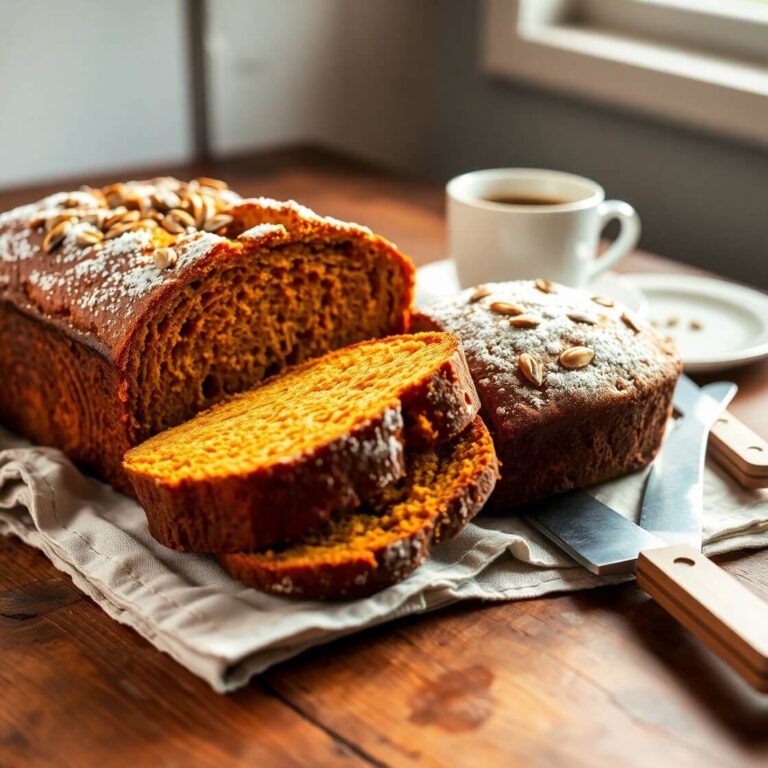
I still remember the first time I tasted an olive oil cake—it wasn’t too sweet, it was soft, citrusy, and had a surprising richness that I hadn’t expected. Unlike traditional butter-based cakes, this one had a beautiful golden crust and a moist, tender crumb that made it unforgettable.
So why make an olive oil cake? Because it’s a simple, elegant dessert with depth of flavor, minimal fuss, and an earthy charm that works just as well on a weekday table as it does at a dinner party. It’s the kind of cake that makes you feel like you’re in a rustic countryside kitchen, even if you’re just baking on a quiet Sunday afternoon.
This recipe will guide you through making a rich and aromatic olive oil cake that’s light, beautifully balanced, and incredibly easy to make. Whether you’re new to baking or a seasoned home cook, this guide is for you.
Why I Love This Recipe

This olive oil cake is one of those magical recipes that checks all the boxes: it’s simple to make, uses pantry staples, and tastes like something you’d find at a high-end bakery.
What makes it so special?
First, olive oil adds a unique complexity. While butter gives richness, olive oil gives fruitiness and depth, not to mention it keeps the cake moist for days. You don’t even need a mixer for this recipe—just a whisk and two bowls. That means fewer dishes, more flavor, and a no-fuss approach to a classic, comforting cake.
Another reason I adore this recipe is its versatility. You can keep it plain and serve it with tea or coffee, or dress it up with whipped cream and fruit for a show-stopping dessert. And the citrus notes? They elevate the cake with a fresh, zesty finish that keeps you coming back for another slice.
It’s also an ideal make-ahead dessert. In fact, it gets better with time, making it perfect for preparing a day in advance for brunches, dinner parties, or any celebration.
Ingredients for Olive Oil Cake
Let’s talk about what you’ll need to bring this cake to life—and why each ingredient matters.
You might be surprised at how simple the list is. That’s part of the magic: basic pantry ingredients come together to create something extraordinary.
Here’s what you’ll need:
- High-quality olive oil: This is the star of the show. Choose extra virgin olive oil for the best flavor—fruity, grassy, slightly peppery. Avoid strong or overly bitter oils; a mellow one works beautifully.
- All-purpose flour: The structure of your cake. Keep it simple with regular flour; no need for anything fancy.
- Granulated sugar: Adds sweetness and helps with browning. The sugar also balances the olive oil’s flavor and supports the citrus.
- Eggs: They provide structure and richness. Use room-temperature eggs so they mix more evenly.
- Milk or buttermilk: For moisture and tenderness. Buttermilk adds a slight tang, which complements the olive oil perfectly.
- Orange zest and juice: A bright, citrusy layer of flavor. Lemon works too, but orange is traditional and adds warmth.
- Baking powder and baking soda: Your leavening agents. They help the cake rise and give it that beautiful dome.
- Salt: Just a pinch, to balance and enhance the other flavors.
- Vanilla extract: For warmth and subtle sweetness.
Every one of these ingredients plays a role in building layers of flavor and creating that gorgeous, golden texture. It’s amazing how something so simple can turn out so special.
How Much Time Will You Need
This olive oil cake is efficient and rewarding—a quick bake with big results.
- Preparation Time: 15 minutes
- Baking Time: 40 to 45 minutes
- Cooling Time: 1 hour (ideal for slicing)
- Total Time: Around 2 hours (with cooling)
You can easily prepare the batter in under 20 minutes, and while the cake bakes, your kitchen will fill with the warm, citrusy scent of olive oil and orange. It’s incredibly satisfying and smells like comfort.
How to Make This Olive Oil Cake

Follow these detailed steps, and you’ll have a perfect olive oil cake every time.
Step – 1: Preheat and Prepare Your Pan
Start by preheating your oven to 350°F (175°C). Grease a 9-inch round cake pan with olive oil or nonstick spray, then line the bottom with parchment paper for easy removal.
Step – 2: Combine the Dry Ingredients
In a medium bowl, whisk together 2 cups of all-purpose flour, 1 ½ teaspoons of baking powder, ¼ teaspoon of baking soda, and ½ teaspoon of salt. Set this aside.
Step – 3: Whisk the Wet Ingredients
In a large mixing bowl, whisk together 1 cup of sugar and 3 large eggs until the mixture is light and frothy—about 1 to 2 minutes. This aerates the batter and helps the cake rise.
Add ¾ cup of high-quality extra virgin olive oil, ½ cup of buttermilk (or milk), the zest of 1 large orange, ¼ cup of freshly squeezed orange juice, and 1 teaspoon of vanilla extract. Mix until smooth and fully combined.
Step – 4: Combine the Wet and Dry
Gradually add the dry ingredients to the wet mixture. Use a spatula to fold them together gently—don’t overmix. Stop as soon as you don’t see any dry streaks of flour.
Step – 5: Pour and Smooth the Batter
Pour the batter into your prepared pan. Use a spatula to smooth the top evenly so the cake bakes level.
Step – 6: Bake
Place the pan in the center of your oven. Bake for 40 to 45 minutes, or until the top is golden and a toothpick inserted in the center comes out clean or with a few moist crumbs.
Step – 7: Cool
Let the cake cool in the pan for about 15 minutes. Then turn it out onto a wire rack and let it cool completely—at least an hour. The flavor develops as it cools, so don’t rush this step.
Step – 8: Serve
Dust the top with powdered sugar, garnish with orange slices or fresh herbs (like rosemary), and serve at room temperature.
Substitutions
Sometimes you need to adjust based on what’s in your pantry—or dietary preferences. This cake is flexible and forgiving.
Want a hook? You can make this cake your own without sacrificing texture or flavor.
- Flour: Swap all-purpose with cake flour for an even lighter texture, or use half whole wheat flour for a nuttier, heartier version.
- Sugar: Try coconut sugar or light brown sugar for a deeper, molasses-like flavor. Honey or maple syrup can work, but you’ll need to adjust the liquid content.
- Buttermilk: No buttermilk? Use ½ cup of whole milk mixed with 1 teaspoon of lemon juice or vinegar. Let it sit for 5 minutes before using.
- Citrus: Orange not your thing? Lemon or grapefruit both work beautifully. You could even try a mix.
- Vanilla: Almond extract makes for a lovely twist—just use half the amount since it’s stronger.
- Eggs: For a vegan version, use flax eggs (1 tablespoon ground flaxseed + 3 tablespoons water = 1 egg), though the texture will be denser.
Best Side Dish of Olive Oil Cake
Olive oil cake pairs wonderfully with other light, fresh dishes. Here are three side companions that make it a complete experience:
- Fresh Berries with Mint: A small bowl of chilled strawberries, raspberries, and blueberries tossed with mint leaves is refreshing and bright.
- Greek Yogurt with Honey: A spoonful of thick Greek yogurt drizzled with honey adds a creamy contrast to the cake’s delicate crumb.
- Lemon Sorbet: Tart and icy, lemon sorbet is the perfect way to cleanse your palate between bites.
Serving and Presentation Tips
Want to make your olive oil cake unforgettable? It’s all in how you serve it.
Presentation matters just as much as flavor—especially when you’re proud of what you’ve made. This cake is naturally beautiful with its golden color and gentle crumb, but a few finishing touches can take it from rustic to restaurant-worthy.
- Dust with powdered sugar: A simple sprinkle of powdered sugar adds elegance. Use a fine mesh sieve for even coverage.
- Add citrus garnish: Thin slices of orange, candied peel, or zest curls not only hint at the flavor inside but also create a vibrant visual.
- Serve with a drizzle: A touch of olive oil, honey, or citrus glaze poured over each slice can elevate the texture and taste.
- Pair with fresh fruit: Plate slices with fresh berries, figs, or poached pears to bring in a pop of color and freshness.
- Use a cake stand: It sounds simple, but elevating the cake—literally—on a stand can make a big difference in presentation.
Keep it clean, let the cake shine, and match your presentation to the occasion—whether it’s a casual brunch or a refined dessert spread.
Tips and Tricks to Make This Recipe Even Better

Great cakes aren’t just baked—they’re thoughtfully crafted.
Over time, I’ve picked up a few smart techniques that help bring out the very best in this olive oil cake. Use these tips to make yours more flavorful, more tender, and even longer-lasting.
- Use room temperature ingredients: Cold eggs or milk can seize the olive oil, creating a dense batter. Let your ingredients sit out for 30 minutes first.
- Don’t overmix: The batter should be just combined. Overmixing develops gluten and can make the cake tough.
- Choose your olive oil carefully: The flavor of the oil comes through, so pick one with a smooth, fruity profile. Too bitter or grassy? It might overwhelm the cake.
- Let it rest: This cake actually improves after a day. Wrap it in foil or store in an airtight container, and let the flavors meld.
- Try it with a glaze: Mix powdered sugar and orange juice for a simple citrus glaze to add sweetness and shine.
These small adjustments can add up to big improvements. Follow them, and your olive oil cake will always taste bakery-quality.
Common Mistakes to Avoid
Even simple cakes can go wrong if you’re not careful. Here’s what to watch out for.
- Using strong-flavored olive oil: A very bitter or pungent oil can overpower the cake’s delicate balance. Always taste the oil before using it in the recipe.
- Skipping the citrus zest: The zest adds aroma and depth you can’t get from juice alone. Don’t leave it out.
- Overbaking: This is a moist cake, and overbaking can dry it out. Always check for doneness a few minutes before the recommended time.
- Not lining the pan: Even if you grease the pan, the cake can stick. Always line the bottom with parchment paper.
- Serving too early: Let the cake cool completely before slicing. If it’s still warm, it may crumble and fall apart.
Being aware of these pitfalls will save you from disappointment and ensure you get a perfect result every time.
How to Store It
One of the great things about olive oil cake is how well it keeps.
Here’s how to store it to keep it fresh and moist for as long as possible:
- Room temperature: Wrap the cooled cake tightly in plastic wrap or store in an airtight container. It will stay fresh for up to 4 days.
- Refrigerator: If your kitchen is warm, refrigeration helps. Place it in an airtight container and bring it to room temperature before serving. It may lose a bit of softness but will still taste great.
- Freezer: You can freeze the whole cake or individual slices. Wrap tightly in two layers of plastic wrap and one layer of foil. Freeze for up to 2 months. Thaw overnight in the fridge or a few hours at room temperature.
This cake is an ideal make-ahead dessert. In fact, its flavor improves on day two, making it perfect for prepping ahead of a gathering.
FAQ
What kind of olive oil should I use?
Use a mild, fruity extra virgin olive oil. Avoid overly bitter or sharp varieties, as the flavor comes through in the cake.
Can I make this gluten-free?
Yes! Substitute the flour with a gluten-free 1:1 baking flour blend. The texture might be slightly different but still delicious.
Can I use lemon instead of orange?
Absolutely. Lemon zest and juice work beautifully in this recipe and give it a bright, slightly more tart flavor.
How do I make this cake vegan?
Use a plant-based milk (like almond or oat) and substitute each egg with a flax egg. The texture will be slightly denser but still moist.
Can I add herbs or spices?
Yes! Rosemary or thyme pairs beautifully with citrus. You could also add a pinch of cinnamon or cardamom for warmth.
Olive Oil Cake
A golden, citrus-kissed cake made with rich olive oil and simple ingredients—this olive oil cake is light, moist, and elegant with a rustic charm. Perfect with tea, brunch, or dressed up with whipped cream and berries, it’s a one-bowl wonder that tastes better the next day. No mixer required, just a whisk, a bowl, and your favorite olive oil. Whether you’re baking for friends or just treating yourself, this cake delivers big flavor with minimal effort.
- Prep Time: 15 minutes
- Cook Time: 45 minutes
- Total Time: 2 hours
- Yield: 8
- Category: Dessert
- Method: Baking
- Cuisine: Mediterranean-Inspired
- Diet: Vegetarian
Ingredients
- 2 cups all-purpose flour
- 1 ½ tsp baking powder
- ¼ tsp baking soda
- ½ tsp salt
- 1 cup granulated sugar
- 3 large eggs (room temperature)
- ¾ cup extra virgin olive oil (mild and fruity)
- ½ cup buttermilk
- Zest of 1 orange
- ¼ cup fresh orange juice
- 1 tsp vanilla extract
Instructions
- Preheat oven to 350°F (175°C). Grease a 9-inch round pan and line the bottom with parchment paper.
- In a medium bowl, whisk flour, baking powder, baking soda, and salt.
- In a large bowl, whisk sugar and eggs until frothy.
- Add olive oil, buttermilk, orange zest and juice, and vanilla. Mix until smooth.
- Fold in dry ingredients until just combined.
- Pour into prepared pan. Smooth the top.
- Bake for 40–45 minutes or until golden and a toothpick inserted comes out clean.
- Cool in the pan for 15 minutes, then turn onto a wire rack. Cool completely before serving.
- Dust with powdered sugar before serving.
Notes
- For a lighter texture, substitute half the flour with cake flour.
- Letting the cake rest overnight enhances its flavor.
- Optional: Add a simple orange glaze for extra sweetness.
Nutrition
- Serving Size: 8
- Calories: 360
- Sugar: 20g
- Sodium: 180mg
- Fat: 19g
- Saturated Fat: 3g
- Unsaturated Fat: 15g
- Trans Fat: 0g
- Carbohydrates: 40g
- Fiber: 1g
- Protein: 5g
- Cholesterol: 55mg







